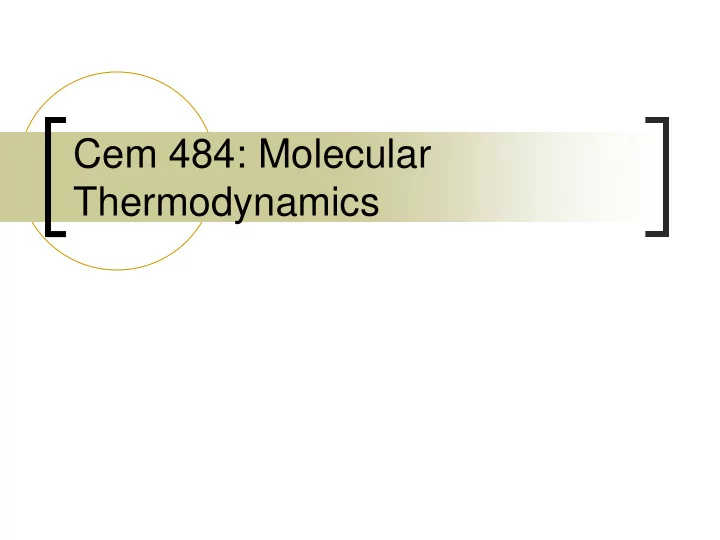

Cem 484: Molecular Thermodynamics
Prof. Liddick Office: NSCL 1006 Email: liddick@chemistry.msu.edu Office hours: Tues. 8 – 9:30 am Wed. 1:30 – 3:00 pm Molecular Thermodynamics CEM 484 2
TAs and office hour TAs Jared Hansen Zhongqi Jin Recitations Sec 1, Rm. 110 – Thurs. 10:20 am – 11:10 am, JH Sec 2, Rm. 109 – Wed. 9:10 am 10:00 am, JH Sec 3, Rm. 109 – Fri. 11:30 am – 12:20 pm, ZJ Sec 4, Rm. 109 – Fri. 9:10 am – 10:00 am, ZJ Molecular Thermodynamics CEM 484 3
Grading scale Final grade based on average of Avg. Grade in-class exams >85 4.0 Exams – 4 in-class exams 80 – 84.9 3.5 All exams are cumulative 75 – 79.9 3.0 Extra credit questions on each exam 65 – 74.9 2.5 Iclicker – treated as extra credit 60 – 64.9 2.0 and added to final score 55 – 59.9 1.5 Attendance (class and recitation) 50 – 54.9 1.0 is not mandatory – but can help <50 0.0 Molecular Thermodynamics CEM 484 4
Syllabus Webpage - http://www2.chemistry.msu.edu/courses/cem484/index.html Three main topics in cem 484 Molecular spectroscopy Statistical Thermodynamics Thermodynamics Link between the concepts from introductory chemistry (macroscopic) and studies from cem 483 (microscopic) Molecular Thermodynamics CEM 484 5
Connections – simple gas molecules Microscopic Macroscopic Quantum mechanics Chemical Thermodynamics Molecular Orbital diagrams Gases characterized by P,V,T H 2 Heat capacities Want to know how to go between these two regimes Basis of modern chemistry Molecular Thermodynamics CEM 484 6
Connections – simple gas molecules Microscopic Macroscopic H 2 atom Chemical Thermodynamics What is the structure, Is a chemical reaction nature of bonding and allowed? energy states? Where is the equilibrium? Verified with measurements Does it release heat? – molecular spectroscopy How can it be manipulated? System Surroundings Molecular Thermodynamics CEM 484 7
Connections Quantum Mechanics Thermodynamics State of system is completely Two bodies in thermal defined by its wavefunction, equilibrium are at the same Physical observables replaced by temperature operators Conservation of energy Can only measure eigenvalues of D U univ = D U sys + D U surr operator No real process is reversible Average value of an observable – D S univ > 0 corresponds to operator Wavefunction of system can Entropy of a pure perfect evolve in time substance at 0 K = 0. Molecular Thermodynamics CEM 484 8
Connections – simple gas molecules Microscopic Macroscopic H elec + H vib + H rot Chemical predictions from thermodynamic state functions D U sys – internal energy D H sys – enthalpy UV/Vis spectroscopy D S sys – entropy Electronic states D A sys – helmoltz free energy IR spectroscopy D G sys – gibbs free energy Vibrational and rotational Measure / assign some and states use reaction to predict Microwave spectroscopy remainder Rotational states Molecular Thermodynamics CEM 484 9
Overview Chemical Molecular Thermodynamics Spectroscopy Statistical Energy Heat Mechanics Levels Capacities Molecular Thermodynamics CEM 484 10
Recommend
More recommend